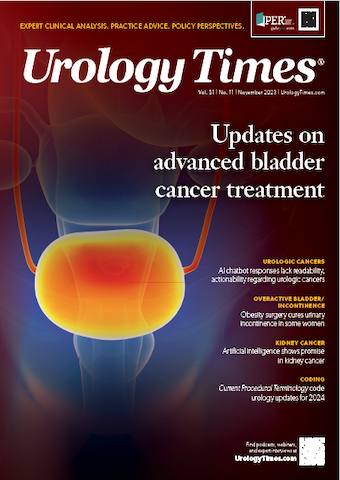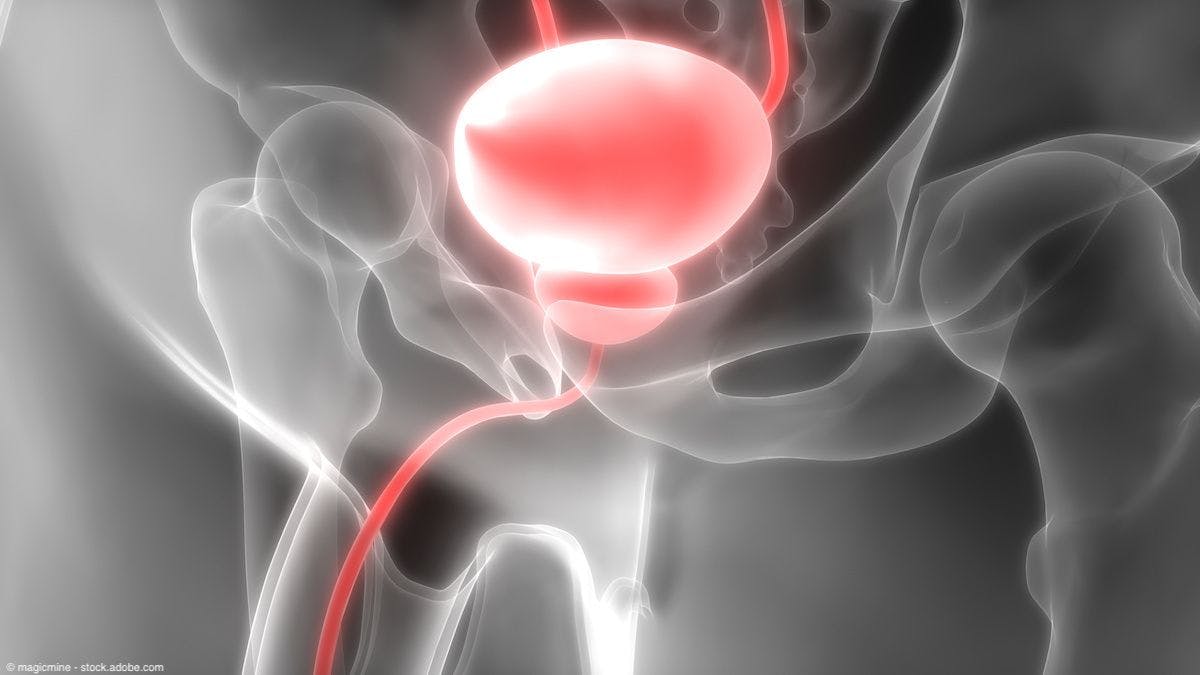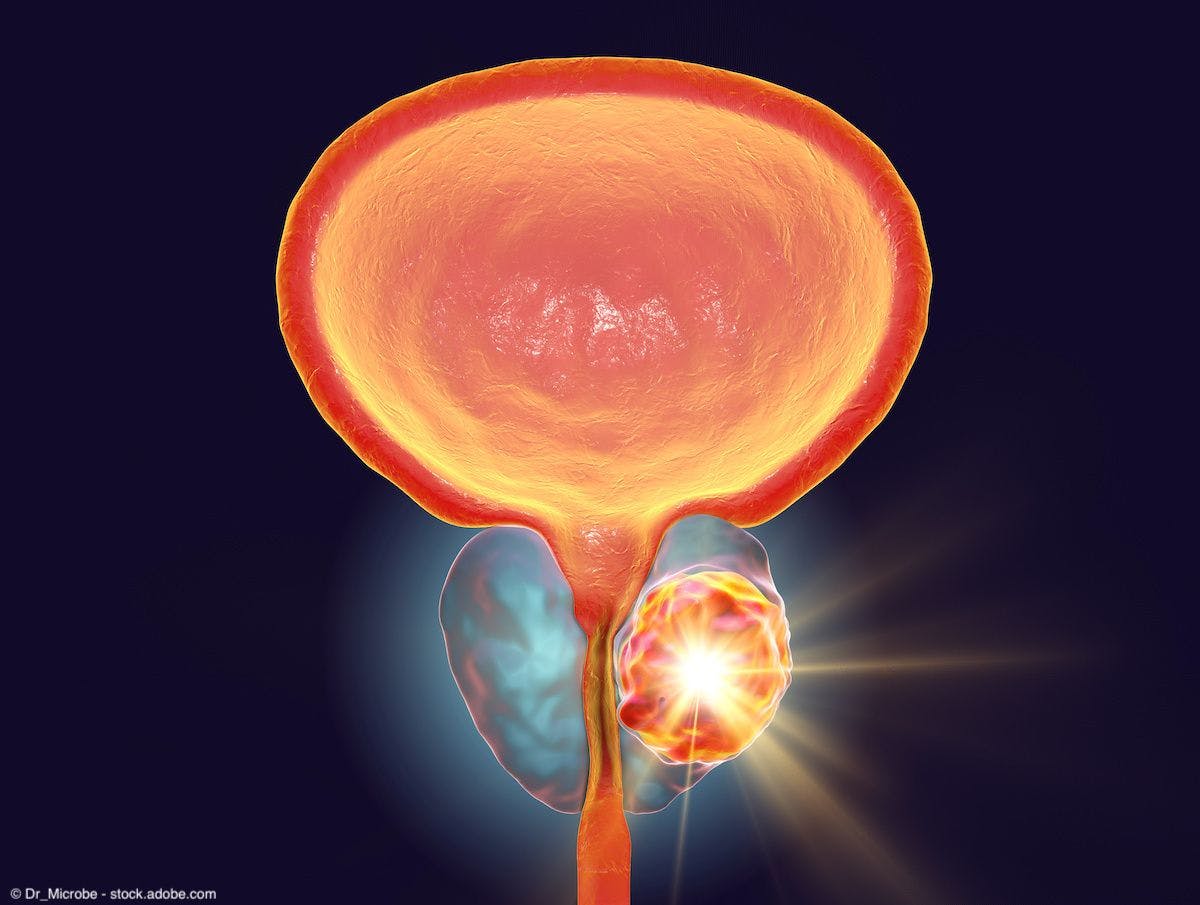Opinion
Article
Urology Times Journal
Current Procedural Terminology code urology updates for 2024
Author(s):
"Many of the new codes are CPT Category III codes, which will require additional research for both coverage and payment rates, especially with private payers," write Jonathan Rubenstein, MD, and Mark Painter.
Jonathan Rubenstein, MD

Current Procedural Terminology (CPT) for 2024 has been released. The changes to the CPT code set discussed below represent changes we have identified for urology and will take effect on January 1, 2024, for all payers. Pricing and coverage will be finalized for some but not all of these new procedure codes first for Medicare with the release of the Medicare Physician Fee Schedule at the end of October or the beginning of November. We will update you on these decisions and the projected impact for urology.
Many of the new codes are CPT Category III codes, which will require additional research for both coverage and payment rates, especially with private payers. It is important to remember that CPT Category III codes are officially CPT codes and must be used to report the services provided if they best describe the services provided, unless you have been instructed otherwise by a payer. (We recommend that you get this in writing.) Medicare typically does not assign work relative value units (wRVUs) to CPT Category III codes; however, it is becoming more common for Medicare to cover Category III services. Some Medicare Administrative Contractors (MACs) will even publish local coverage articles. The Centers for Medicare & Medicaid Services (CMS) may also assign Category III codes to payment categories for ambulatory surgical centers and hospital outpatient department payment classifications, ensuring specific payments to facilities even without setting payment rates for physician services or coverage for the service, drug, or supply.
Evaluation and management (E/M) code updates
Mark Painter

The E/M section of CPT has undergone a few administrative changes for 2024, which ultimately are relatively minor updates compared with the significant changes that took place in 2021 and 2023. There are 2 changes of note that we will address here.
First, to improve consistency, CPT is changing the way time is listed for Office and other Outpatient E/M codes. Currently, these codes include a time “range” as part of the description and to guide code selection. In 2024, these codes will now instead include a time “threshold” to align and for consistency with other (non-Outpatient) E/M codes that use a time threshold. For example, the current descriptor of CPT code 99204 is “Office or other outpatient visit for the evaluation and management of a new patient, which requires a medically appropriate history and/or examination and moderate level of medical decision-making. When using time for code selection, 45 [to] 59 minutes of total time is spent on the date of the encounter.” In 2024, the description will be changed to “Office or other outpatient visit for the evaluation and management of a new patient, which requires a medically appropriate history and/or examination and moderate level of medical decision-making. When using total time on the date of the encounter for code selection, 45 minutes must be met or exceeded.” The time threshold concept does not change the time ranges that are currently in place, so E/M tools will not require updating.
Second, CPT has added a definition of a Shared/Split visit. It would appear that the American Medical Association is hoping to stop the CMS from moving forward with a proposal to allow only visits provided by a medical team of an advanced practice provider (APP) and physician to be reported based on the time spent by each provider. As noted in the definition, Shared/Split visits should be defined by either time or by the substantive portion of the medical decision-making to determine whether the APP or the physician should report the service.
New Category I CPT codes
• 52284 (cystourethroscopy, with mechanical urethral dilation and urethral therapeutic drug delivery by drug coated balloon catheter for urethral stricture or stenosis, male, including fluoroscopy, when performed)
New code 52284 replaces the (to be deleted) Category III code 0499T (cystourethroscopy, with mechanical dilation and urethral therapeutic drug delivery for urethral stricture or stenosis, including fluoroscopy, when performed). This new code is used for reporting cystourethroscopy with mechanical urethral dilation of a urethral stricture using a specialized drug-coated balloon that then provides urethral therapeutic drug delivery. The procedure has a proposed wRVU of 3.10 and has a 0-day global. CPT code 52284 is not an add-on code, and CPT codes 52000, 52281, 52283, 74450, and 76000 are included and should not be reported separately. It is important not to confuse code 52284 with the unique (but similar-sounding) CPT Category III code 0619T (cystourethroscopy with transurethral anterior prostate commissurotomy and drug delivery, including transrectal ultrasound and fluoroscopy, when performed). Code 0619T is similar in that it also uses a balloon and also delivers a drug, but it differs as it is a different balloon using a different surgical technique on a different organ (the prostate rather than the urethra). Therefore, it is vitally important to not mistake the procedures or balloons used or indications with one another.
• 64596 (insertion or replacement of percutaneous electrode array, peripheral nerve, with integrated neurostimulator, including imaging guidance, when performed; initial electrode array)
• +64597 (each additional electrode array) (add-on code)
• 64598 (revision or removal of neurostimulator electrode array, peripheral nerve, with integrated neurostimulator)
New codes 64596, 64597, and 64598 have been added to accommodate the insertion of peripheral nerve stimulators that utilize an array with an integrated (not separate) stimulator. These codes cannot be used for procedures using integrated devices on the sacral nerve (which will be reported using the new Category III codes 0786T-0790T, percutaneous implantation of neurostimulator,sacral, with integrated neurostimulator) or tibial nerve if being used for bladder dysfunction (which will be reported using the new Cateogry III codes 0816T-0819T, described in more detail below).
• 99459 Female pelvic exam (list separately in addition to code for primary procedure)
• 99459 is a practice expense–only code that captures the direct practice expenses associated with performing a female pelvic exam in the nonfacility setting during a preventive medicine service (99381-99397) or E/M service (99202-99215). As an add-on code, it should be reported only for the same date of service with the codes listed above.
Revised Category I CPT codes
The following codes contain revised descriptors, with changes in bold. These will be used for dates of service on or after January 1, 2024.
• 64590 (insertion or replacement of peripheral, sacral, or gastric neurostimulator pulse generator or receiver, requiring pocket creation and connection between electrode array and pulse generator or receiver)
• 64595 (revision or removal of peripheral, sacral, or gastric neurostimulator pulse generator or receiver, with detachable connection to electrode array)
CPT codes 64590 and 64595 are used to report the insertion/replacement and revision/removal, respectively, of a sacral neurostimluator generator or receiver that is attached to a separately placed (concomitant or as a stand-alone procedure) electrode array. These codes were revised for 2024 to clarify that the devices reported by these codes are those that are attached to a separately placed array by replacing the term “direct or inductive coupling” with “connection between array and pulse generator and receiver.” In addition, the descriptors were updated to further differentiate these codes from the codes for reporting procedures involving integrated (generator or receiver with attached or integral array implanted as a single unit) neurostimulator system because of the introduction of new codes for open integrated tibial nerve neurstimulator procedures, percutaneous integrated sacral neruostimulator systems procedures, and percutaneous integrated peripheral nerve stimulator procedures. These codes also have proposed updated RVU values, as 64590 is now valued at 5.10 wRVUs and 64595 now valued at 3.79 wRVUs.
When used for sacral nerve procedures, CPT code 64590 is used in conjunction (concomitantly or as a stand-alone procedure) with code 64561 for percutaneous (trial or permanent) placement of the electrode array. The updated parentheticals provide instruction not to report code 64590 with code 64595 or in conjunction with new Category I codes 64596, 64597, or 64598 (integrated peripheral nerve stimulation procedures).
New and revised Category III codes
• 0587T (percutaneous implantation or replacement of integrated single device neurostimulation system for bladder dysfunction including electrode array and receiver or pulse generator, including analysis, programming, and imaging guidance when performed, posterior tibial nerve)
• 0588T (revision or removal of percutaneously placed integrated single device neurostimulation system for bladder dysfunction including electrode array and receiver or pulse generator, including analysis, programming, and imaging guidance when performed, posterior tibial nerve)
• 0589T (electronic analysis with simple programming of implanted integrated neurostimulation system for bladder dysfunction [eg, electrode array and receiver], including contact group[s], amplitude, pulse width, frequency [Hz], on/off cycling, burst, dose lockout, patient-selectable parameters, responsive neurostimulation, detection algorithms, closed-loop parameters, and passive parameters, when performed by physician or other qualified health care professional, posterior tibial nerve, 1-3 parameters)
• 0590 (electronic analysis with complex programming...4 or more parameters)
• 0816T (open insertion or replacement of integrated neurostimulation system for bladder dysfunction including electrode[s] [eg, array or leadless], and pulse generator or receiver, including analysis, programming, and imaging guidance when performed, posterior tibial nerve; subcutaneous)
• 0817T (…subfascial)
• 0818T (revision or removal of integrated neurostimulation system for bladder dysfunction, including analysis, programming, and imaging, when performed, posterior tibial nerve; subcutaneous)
• 0819T (…subfascial)
Neurostimulator technology is constantly advancing. For use on the tibial nerve for patients with bladder dysfunction, 4 new Category III codes have been added for reporting various procedures related to these devices. Arrays or integrated devices (stimulator with attached or internal array) can be implanted using open surgical (0816T-0819T) or percutaneous approaches (0587T and 0588T). The surgical service required to insert these devices is the primary difference within each CPT code. It will be important to communicate clearly to your entire team the approach used to implant the device used for each patient.
Programming these devices on the day of the procedure is included. For electronic analysis with programming of integrated or leadless neurostimulation system for bladder dysfunction, posterior tibial nerve, performed on a day subsequent to the device insertion, replacement, or revision, use codes 0589T and 0590T for simple (1-3 parameters) and complex (4 or more parameters) programming respectively. Codes 0589T and 0589T should be reported for reprogramming of all posterior tibial devices regardless of insertion path for days subsequent to implantation of the device.
Examples of subcutaneous devices include the eCoin device and Medtronic’s implantable tibial neuromodulation device, whereas an example of a subfascial device is the Revi device. It is important to understand that these devices are placed in an open procedure compared with devices using a percutaneous approach targeting the tibial nerve that are reported using currently existing Category III codes (0587T, 0588T).
• 0786T (insertion or replacement of percutaneous electrode array, sacral, with integrated neurostimulator, including imaging guidance, when performed)
• 0788T (revision or removal of neurostimulator electrode array, sacral, with integrated neurostimulator)
• 0789T (electronic analysis with simple programming of implanted integrated neurostimulation system [eg, electrode array and receiver], including contact group[s], amplitude, pulse width, frequency [Hz], on/off cycling, burst, dose lockout, patient-selectable parameters, responsive neurostimulation, detection algorithms, closed-loop parameters, and passive parameters, when performed by physician or other qualified health care professional, spinal cord or sacral nerve, 1-3 parameters)
• 0790T (electronic analysis with complex programming...4 or more parameters)
0786T and 0788T should be used to report the percutaneous insertion/replacement or revision/removal respectively of an integrated sacral neurostimulator. Although some may believe that the sacral nerve to be a peripheral nerve, these codes are specific to procedures involving integrated sacral nerve stimulation devices so one should not report codes 64596-64598 if targeting the sacral nerve. These codes should not be reported for the placement of an array alone (which would be reported using CPT code 64561) or a generator/receiver alone (CPT code 64590) or in combination. Similarly, CPT codes 64561 and 64590 should not be used to report the percutaneous placement of an integrated neurostimulator. Codes for programming of these devices 0789T and 0790T are not to be reported on the same date of insertion but can be reported based on number of parameters programmed on dates subsequent to the insertion.
• 0811T (remote multiday complex uroflowmetry [eg, calibrated electronic equipment]; setup and patient education on use of equipment)
• 0812T (device supply with automated report generation, up to 10 days)
• 0811T and 0812T have been added to report remote multiday complex uroflowmetry; 1 code is for reporting educating the patient on the use of the equipment, and the other is for reporting device supply with report generation. The parentheticals instruct one not to report code 0812T more than once per episode of care and that these codes should not be reported with CPT codes 51736 (simple uroflow), 51741 (complex uroflow), 99453, and 99454 (remote patient monitoring codes).
• 0864T (low-intensity extracorporeal shock wave therapy involving corpus cavernosum, low energy)
Use 0864T to report the performance of low-intensity extacorporeal shock wave therapy to the corpus cavernosum. This procedure is indicated in men with erectile dysfunction. The parenthetical instructs one not to report code 0864T in conjunction with code 0101T (extracorporeal shock wave involving musculoskeletal system, not otherwise specified) when treating the same area.
Conclusion
Urologic problems continue to be a focus of new drugs, biologicals, and devices. These new codes have been added to more accurately track, cover, and reimburse these new treatments. New J codes and pass-through technology codes for payment of new technology for facility reimbursement related to the services will keep us all on our toes. As previously mentioned, coverage and payment for newer technology are separate from the addition of new codes.
Medicare is now requiring each MAC to evaluate new technology regardless of the type of code used to report the associated procedures and for the new drugs and devices. In years past, Category III codes and unlisted codes were a virtual guarantee of nonpayment. With Medicare’s new requirements in conjunction with the pace of new technology, Category III codes and unlisted codes are routinely covered and most practices have learned to navigate the complexities of reimbursement surrounding this complicated system.
Private payers, of course, play by their own rules. Although the Health Insurance Portability and Accountability Act requires that all payers and medical groups adopt new CPT codes when they are considered official, the processing, coverage, and programming for each of the private payers is not equal, and they do have some leeway to navigate the adoption of these new codes in a timely manner. We will once again add our standard disclaimer that you must check with your payer for the most current information, a decidedly more frustrating problem as payers are more difficult than ever to contact.
Setting fees for new codes without relative values should be based in relative effort to established services where possible and include adequate money to cover the costs associated with these new devices and drugs. It is wise to have on hand invoices to support costs incurred if asked.
Finally, new devices, drugs, and techniques will often require support for medical necessity. We encourage you to take the time to study each of these new service lines for clinical efficacy. Retain either in the medical record or within easy reach of your prior authorization and billing team documentation supporting the patient selection criteria and comparative documentation—preferably peer-reviewedliterature—for each patient. Your group will need to have agreed upon and followed the protocols and data supported by the literature to be paid and retain reimbursements for all services provided, but these need to be emphasized for new services.
We love the pioneering spirit of urology groups choosing to support the evolution of patient care; it is not without risk, but it can be rewarding for both your patients and your practice.





























